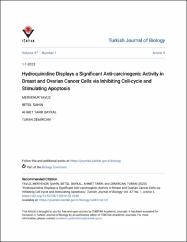| dc.contributor.author | Yavuz, Mervenur | |
| dc.contributor.author | Demircan, Turan | |
| dc.contributor.author | Şahin, Betül | |
| dc.contributor.author | Baykal, Ahmet Tarık | |
| dc.date.accessioned | 2023-03-07T08:50:30Z | |
| dc.date.available | 2023-03-07T08:50:30Z | |
| dc.date.issued | 2023 | en_US |
| dc.identifier.citation | YAVUZ, MERVENUR; ŞAHİN, BETÜL; BAYKAL, AHMET TARIK; and DEMİRCAN, TURAN (2023) "Hydroquinidine Displays a Significant Anti-carcinogenic Activity in Breast and Ovarian Cancer Cells via Inhibiting Cell-cycle and Stimulating Apoptosis,"
Turkish Journal of Biology: Vol. 47: No. 1, Article 5. https://doi.org/10.55730/1300-0152.2640 | en_US |
| dc.identifier.issn | 1300-0152 / 1303-6092 | |
| dc.identifier.uri | https://doi.org/10.55730/1300-0152.2640 | |
| dc.identifier.uri | https://hdl.handle.net/20.500.12809/10571 | |
| dc.description.abstract | Breast and ovarian cancers are women’s most commonly diagnosed cancers. Seeking an efficient anticarcinogenic compound is still a top priority regarding the aggressiveness of these cancers and the limited benefit of current therapies. Hydroquinidine (HQ) is a natural alkaloid used in arrhythmia and Brugada syndrome. As an ion channel blocker, HQ exhibits its activity by altering ion gradient and membrane potential. Considering the growing evidence of ion channel blockers’ antineoplastic potential, we were prompted to test HQ’s effect on breast and ovarian cancers. MCF-7 and SKOV-3 cell lines were used to inspect how HQ acts on survival, clonogenicity, migration, tumorigenicity, proliferation, and apoptosis. The molecular basis for the remarkable antiproliferative and proapoptotic effect of HQ in these cells was dissected by proteomics. CDK1, PSMB5, PSMC2, MCM2, MCM7, YWHAH, YWHAQ, and YWHAB proteins in HQ-treated MCF-7 cells, and RRM2, PSMD2, PSME2, COX2, COX4l1, and CDK6 proteins in HQ-treated SKOV-3 cells were found as low-abundant, which was noteworthy. Based on the in-depth analysis, upon HQ treatment, several cell cycle-related processes were found as suppressed, whereas apoptosis and ferroptosis pathways were found to be activated. The observed proteome alteration in cancer cells may provide mechanistic explanations for the growth-limiting effects of HQ at the cellular level. | en_US |
| dc.item-language.iso | eng | en_US |
| dc.publisher | TUBITAK | en_US |
| dc.relation.isversionof | 10.55730/1300-0152.2640 | en_US |
| dc.item-rights | info:eu-repo/semantics/openAccess | en_US |
| dc.subject | Cancer | en_US |
| dc.subject | Hydroquinidine | en_US |
| dc.subject | Proteomics | en_US |
| dc.subject | MCF-7 | en_US |
| dc.subject | SKOV-3 | en_US |
| dc.subject | Anticancer agent | en_US |
| dc.title | Hydroquinidine displays a significant anticarcinogenic activity in breast and ovarian cancer cells via inhibiting cell-cycle and stimulating apoptosis | en_US |
| dc.item-type | article | en_US |
| dc.contributor.department | MÜ, Tıp Fakültesi, Temel Tıp Bilimleri Bölümü | en_US |
| dc.contributor.authorID | 0000-0003-2274-9752 | en_US |
| dc.contributor.authorID | 0000-0002-2424-9893 | en_US |
| dc.contributor.institutionauthor | Yavuz, Mervenur | |
| dc.contributor.institutionauthor | Demircan, Turan | |
| dc.identifier.volume | 47 | en_US |
| dc.identifier.issue | 1 | en_US |
| dc.identifier.startpage | 44 | en_US |
| dc.identifier.endpage | 60 | en_US |
| dc.relation.journal | Turkish Journal of Biology | en_US |
| dc.relation.publicationcategory | Makale - Uluslararası Hakemli Dergi - Kurum Öğretim Elemanı | en_US |


















